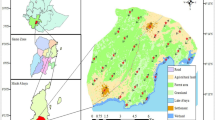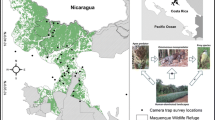Abstract
Carnivores are umbrella species with a key role in ecosystems. In the Mediterranean, they face with several conservation problems, mainly habitat loss or transformation. In this region, scrubland habitats are considered of minor conservation relevance as compared to mature forest formations. Conservation of scrublands in Mediterranean ecosystems is also difficult because to control fires, they are removed over large areas. For carnivores, scrublands may be essential to guarantee shelter and food. Here, we analyzed the importance of scrublands and other habitat variables in determining the richness of medium-sized carnivores in a typical Mediterranean area of central Spain (Monfragüe Natural Park). The Park was divided into plots of 2 × 2 km (n = 30). In each plot, a 2 km-length survey route was walked searching for carnivore scats. We recorded the number of species of carnivores and we related this value to several habitat variables. Habitat variables were summarized by means of Principal Component Analysis (PCA). Habitat models were developed by, using multiple regression models, including PCA factors and the habitat type as predictors. The only variable included in the final model was the first PCA factor. Carnivore richness was positively associated with large tree, shrub, and rock cover areas, which is the typical habitat structure of scrublands. This habitat offers the best available area for shelter and may be considered as a key element for carnivore conservation in the Mediterranean region. To reconciliate carnivore conservation and forestry management, we proposed small-scale clearances as a management alternative to typical large scrubland removals.


Similar content being viewed by others
References
Andelman SJ, Fagan WF (2000) Umbrellas and flagships: Efficient conservation surrogates or expensive mistakes? Proc Natl Acad Sci USA 97:5954–5959
Andelt WF, Andelt SH (1984) Diet bias in scat deposition-rate surveys of coyote density. Wild Soc Bull 12:74–77
Camprodon J (2001) Tratamientos forestales y conservación de la fauna vertebrada. In: Camprodon J, Plana E (eds) Conservación de la Biodiversidad y Gestión Forestal: Su Aplicación en la Fauna Vertebrada. Publicacions i Edicions Universitat de Barcelona, Barcelona, pp 135–179
Caro TM (2003) Umbrella species critique and lessons from East Africa. Anim Conserv 6:171–181
Carrete M, Donazar JA (2005) Application of central-place foraging theory shows the importance of Mediterranean dehesas for the conservation of the Cinereous vulture, Aegypius monachus. Biol Conservs 126:582–590
Carroll C, Zielinski WJ, Noss RF (1999) Using presence-absence data to build and test spatial habitat models for the fisher in the Klamath region, USA. Conserv Biol 13:1344–1359
Carroll C, Noss RF, Paquet PC (2001) Carnivores as focal species for conservation planning in the Rocky Mountain region. Ecol Appl 11:961–980
Cavallini P (1994) Faeces count as an index of fox abundance. Acta Theriol 39:417–424
Clutton-Brock J (1996) Competitors, companions,status symbols, or pests: a review of human associations with other carnivores. In: Gittleman JL (ed) Carnivore Behaviour, Ecology and Evolution, vol 2. Cornell University Press, Ithaca, New York, pp 375–392
Coppolillo P, Gomez H, Maisels F, Wallace R (2004) Selection criteria for suites of landscape species as a basis for site-based conservation. Biol Conserv 115:419–430
De Juana E (2004) Changes in the conservation status of birds in Spain, years 1954 to 2004. Ardeola 51:19–50
Díaz M, Campos P, Pulido F (1997) The Spanish dehesas: a diversity in land use and wildlife. In: Pain DJ, Pienkowski MW (eds) Farming and birds in Europe: The common agricultural policy and its implications for bird conservation. Academic Press, London, pp 178–209
Ferrer M (2001) The Spanish Imperial Eagle. Editorial Lynx, Barecelona, Spain
Font I (1983) Climatología de España y Portugal. Instituto Nacional de Meteorología, Madrid
Gese EM (2001) Monitoring of terrestrial carnivore populations. In: Gittleman JL, Funk SM, Macdonald DW, Wayne KR (eds), Carnivore conservation. Cambridge University Press, Ithaca, New York, pp 372–396
Ginsberg JR, Macdonald DW (1990) Foxes, Wolves, Jackals and Dogs: An Action Plan for the Conservation of Canids. IUCN, Gland, Switzerland
Gittleman JL, Funk SM, Macdonald DW, Wayne RK (2001) Carnivore Conservation. Conservation Biology 5. Cambridge University Press, Cambridge
Graham MH (2003) Confronting multicollinearity in ecological multiple regression. Ecology 84:2809–2815
Guisan A, Zimmermann NE (2000) Predictive habitat distribution models in ecology. Ecol Modell 135:147–186
Gurd DB, Nudds TD, Rivard DH (2001) Conservation of mammals in eastern North American wildlife reserves: How small is too small?. Conserv Biol 15:1355–1363
Herrera CM (1985) Determinants of plant-animal coevolution - the case of mutualistic dispersal of seeds by vertebrates. Oikos 44:132–141
James FC, McCullough CE (1990) Multivariate analysis in ecology and systematics: Panacea or Pandora’s box? Annu Rev Ecol Syst 21:129–166
Linnell JDC, Swenson JE, Andersen R (2000) Conservation of biodiversity in Scandinavian boreal forests: large carnivores as flagships, umbrellas, indicators, or keystones? Biodiv Conserv 9:857–868
Lozano J, Virgós E, Malo A, Huertas DL, Casanovas JG (2003) Importance of scrub-pastureland mosaics on wild-living cats occurrence in a Mediterranean area: implications for the conservation of the wildcat (Felis silvestris). Biodiv Conserv 12:921–935
MacNally R (2000) Regression and model building in conservation biology, biogeography and ecology: the distinction between and reconciliation of ‘predictive’ and ‘explanatory’ models. Biodiv Conserv 9:655–671
Manel S, Dias JM, Buckton ST, Ormerod SJ (1999) Alternative methods for predicting species distribution: an illustration with Himalayan river birds. J Appl Ecol 36:734–747
Médail F, Quezel P (1997) Hot-spots analysis for conservation of plant biodiversity in the Mediterranean basin. Ann Mo Bot Gard 84:112–127
MIMAM (2002) Plan Forestal Español. Dirección General de Conservación de la Naturaleza, Ministerio de Medio Ambiente, Madrid
Mladenoff DJ, Sickley TA, Wydeven AP (1999) Predicting gray wolf landscape recolonization: Logistic regression models vs. new field data. Ecol Appl 9:37–44
Noss RF, Quigley HB, Hornocker MG, Merrill T, Paquet PC (1996) Conservation biology and carnivore conservation in the Rocky Mountains. Conserv Biol 10:949–963
Ozenda P (1982) Les Vegetaux dans le Biosphère. Doin Editeurs, Paris
Peinado M, Rivas-Martínez S (1986) La Vegetación De España. Universidad De Alcalá De Henares, Madrid
Pons P (2001) Consecuencias de los incendios forestales sobre los vertebrados y aspectos de su gestión en regiones mediterráneas. In: Camprodon J, Plana E (eds) Conservación de la Biodiversidad y Gestión Forestal: Su Aplicación en la Fauna Vertebrada. Publicacions i Edicions Universitat de Barcelona, Barcelona, pp 197–211
Prodon R (1987) Fire, bird conservation and land management in the north-Mediterranean area. Ecol Mediterr 13:127–133
Prodon R, Fons R, Peter AM (1984) L’impact du feu sur la végetation, les oiseaux et les micromammifères dans diverses formations méditerranéennes des Pyrénées-Orientales: premiers résultats. Rev Écol (Terre Vie) 39:130–158
Revilla E, Palomares F, Fernández N (2001) Characteristics, location, and selection of diurnal resting dens by Eurasian badgers (Meles meles) in a low density area. J Zool 255:291–299
Scott JM, Heglund PJ, Morrison ML, et al. (2002) Predicting species occurrences. Issues of accuracy and scale. Island Press, Washington
Tellería JL (2001) Passerine bird communities of Iberian dehesas: a review. Anim Biodivers Conserv 24:67–78
Tellería JL, Sáez-Royuela C (1984) The large mammals of Central Spain. An Introduct View. Mammal Rev 14:51–56
Terradas J (1996) Mesures específiques de gestió per a la prevenció d’incendis. In: Terradas J (ed) Ecologia del foc. Proa, pp 209–225
Travaini A, Delibes M, Ferreras P, Palomares F (1997) Diversity, abundance or rare species as a target for the conservation of mammalian carnivores: a case study in Southern Spain. Biodiv Conserv 6:529–535
Tuyttens FAM, Long B, Fawcett T, Skinner A, Brown JA, Cheeseman CL, Roddam AW, Macdonald DW (2001) Estimating group size and population density of Eurasian badgers Meles meles by quantifying latrine use. J Appl Ecol 38:1114–1121
Virgós E (2001) Relative value of riparian woodlands in landscapes with different forest cover for the conservation of medium-sized Iberian carnivores. Biodiv Conserv 10:1039–1049
Virgós E, Casanovas JG (1997) Habitat selection of genet Genetta genetta in the mountains of central Spain. Acta Theriol 42:169–177
Virgós E, Travaini A (2005) Relationship between small-game hunting and carnivore diversity in central Spain. Biodiv Consev 14:3475–3486
Virgós E, Tellería JL, Santos T (2002) Effects of geographic location, vegetation type, isolation and fragment features on the richness and occurrence of medium-sized mammals in forest fragments of central Spain. Biodiv Conserv 11:1063–1079
Webbon C, Baker PJ, Harris S (2004) Faecal counting for monitoring changes in red fox numbers in rural Britain. J Appl Ecol 41:768–779
Wilcox B (1984) In situ conservation of genetic resources: determinants of minimum area requirements. In: McNeely JA, Miller KR (eds) National parks, conservation, and development: the role of protecting areas in sustaining society. Proceedings World Congress on National Parks. Smithsonian Institution Press. Washington, DC, pp 639–647
Wilson GJ, Delahay RJ (2001) A review of the methods to estimate the abundance of terrestrial carnivores using field signs and observation. Wildl Res 28:151–164
Zielinski WJ, Kucera TE (1995) American marten, Fisher, Lynx and Wolverine: Survey Methods for their Detection. General Technical Report PSW-157. US Department of Agriculture Forest Service, Pacific Southwest Research Station, Berkeley, California, USA
Zielinski WJ (1997) Monitoring mesocarnivore population status. In: Harris J, Ogan C (eds) Mesocarnivores of Northern California: Biology, Management, and Survey Techniques. Humboldt State University, Arcata, CA. The Wildlife Society, California North Coast Chapter, Arcata, CA, pp 119–127
Acknowledgements
We thank Paloma García and Álvaro Casanova for their assistance during our field work. The director of Monfragüe Natural Park kindly gave us permission to conduct our surveys within this protected natural reserve. Forestry agents and Luisa Castilla helped us with our field surveys.
Author information
Authors and Affiliations
Corresponding author
Rights and permissions
About this article
Cite this article
Mangas, J.G., Lozano, J., Cabezas-Díaz, S. et al. The priority value of scrubland habitats for carnivore conservation in Mediterranean ecosystems. Biodivers Conserv 17, 43–51 (2008). https://doi.org/10.1007/s10531-007-9229-8
Received:
Accepted:
Published:
Issue Date:
DOI: https://doi.org/10.1007/s10531-007-9229-8




